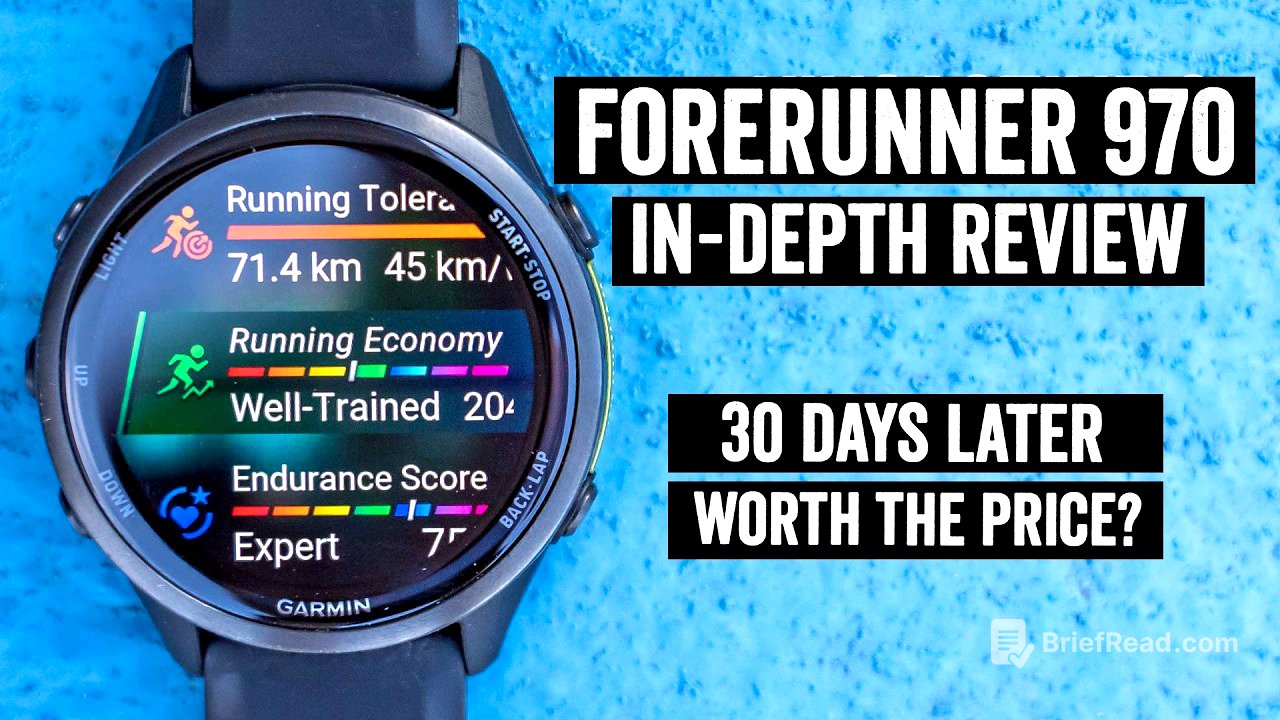TLDR;
This video provides a comprehensive review of the Garmin Forerunner 970, covering its new hardware features like the flashlight, brighter display, and Gen 5 optical heart rate sensor with ECG, as well as software enhancements including running load factor, running tolerance, and race prediction tools. It also discusses the accuracy of GPS and heart rate tracking, and compares the Forerunner 970 to other Garmin models like the Fenix 8, offering recommendations for potential buyers.
- New hardware features: flashlight, brighter display, Gen 5 HR sensor with ECG
- New software features: running load factor, running tolerance, race prediction
- GPS and heart rate accuracy are generally excellent
- The Forerunner 970 is a plastic Fenix 8, but the upgrade is not worth it if you have Forerunner 965
Quick Intro [0:00]
The video introduces the Garmin Forerunner 970, highlighting that the review will cover new features, their real-world performance, and final recommendations. The presenter mentions testing the watch across various activities, including 50k runs, open water swims, and trail runs, to assess its strengths and weaknesses.
The New Flashlight [0:22]
The Garmin Forerunner 970 includes a dedicated LED flashlight, similar to those found in the Fenix and Instinct series. The flashlight has adjustable brightness levels and can be activated with a double tap. It's useful for trail running and everyday tasks, such as navigating hotel rooms. The flashlight can also be set to strobe automatically during runs near sunset to increase visibility.
The Brighter Display [1:08]
The Forerunner 970 features a significantly brighter display compared to the 965, although Garmin does not disclose the exact nit value. The presenter estimates the brightness to be between 1500 and 2000 nits. While the brighter display is an improvement, it can drain the battery quickly, especially in always-on mode. Reducing the brightness to the 1/3 setting provides a good balance between visibility and battery life.
Battery Burn Challenges [1:37]
Using the always-on display setting significantly reduces the battery life of the Forerunner 970. The presenter notes that with the default brightness, the watch lasted only about two days in always-on mode, compared to the typical four to six days for similar Garmin watches. Lowering the brightness to 1/3 restores the battery life to around four days. The presenter suggests that Garmin should offer more granular brightness control with additional toggle options.
New Optical HR Sensor & ECG [3:00]
The Forerunner 970 is equipped with the Gen 5 optical heart rate sensor, which enables ECG functionality for detecting atrial fibrillation (AFib). The device is medically certified for this purpose. To take an ECG, the user must hold the bezel of the watch. Unlike some other devices, the Forerunner 970 does not offer passive AFib detection.
Voice Commands, Calling, Assistants [3:52]
The Forerunner 970 includes a speaker and microphone, allowing users to take voice calls when the watch is connected to a phone. The watch does not have cellular LTE, so it relies on the phone's connection. The speaker quality is better than that of the Fenix 8. The watch also supports voice assistants via the connected phone (Siri for iPhones, Bixby for Samsung phones, and Google Assistant for other Android phones). Additionally, Garmin's voice commands allow users to control watch functions like starting a run.
Upgraded Hardware Materials [5:35]
The Forerunner 970 maintains a 1.4-inch AMOLED display and a 47mm case size. The outer bezel is made of titanium, which is necessary for the ECG function. The case is slightly thinner (0.3mm) than previous models, although this difference is barely noticeable.
Running Impact Factor Explained [6:07]
The Forerunner 970 introduces a running load factor, which adjusts the perceived distance of a run based on elevation changes and intensity. This feature aims to provide a more accurate representation of the effort exerted during a run. The presenter finds the impact load factor to be highly accurate in reflecting how his legs feel after various types of runs.
Running Tolerance: Worth it? [7:05]
The running tolerance feature uses the running load factor to estimate how much load a runner can handle. It displays the runner's impact load over the past seven days, their tolerance level, and their actual seven-day distance. The presenter notes that the watch's estimation of his tolerance seems to lag behind his actual running capacity, as it doesn't scale up quickly enough to match his training volume.
Step Speed Loss Explained [8:11]
The step speed loss metric, along with running economy, requires the new Garmin HRM-600 heart rate strap. Step speed loss measures the percentage of speed lost upon foot impact, indicating running efficiency. This metric is factored into the running economy feature, which assesses overall running efficiency after several runs.
Running Economy Requirements [8:52]
The running economy feature requires about 10-15 km of running data before providing a metric. The presenter criticises the step speed loss and running economy features for favouring slower running speeds and ignoring faster runs, interval runs, and runs with significant elevation changes. He argues that these features seem designed to encourage slower running to improve the graph, rather than for genuine aerobic training purposes.
Future Projected Finish Time [9:49]
The Forerunner 970 can project race finish times based on the user's training. By adding a race to the Garmin calendar, the watch provides training recommendations and an estimated finish time that updates as training progresses. This feature offers insight into potential race performance based on current training efforts.
AutoLap by Timing Gates [10:23]
The AutoLap by Timing Gate feature is activated by checking a box in Garmin Connect. When a race course is loaded onto the watch, this feature automatically adjusts lap splits based on the official timing gates along the course. This compensates for the extra distance runners often cover by swerving around other people, providing more accurate split pacing.
Suggested Finish Line [11:09]
The suggested finish line feature addresses the common issue of forgetting to stop the watch immediately after finishing a race. When the user hits stop, the watch detects that the course ended earlier and offers to trim the extra time and distance, aligning the recorded data with the actual finish line.
Garmin Coach for Triathlon Plans [11:48]
The Forerunner 970 supports triathlon training plans through Garmin Connect. Users can add a race to their calendar, and the platform will generate a comprehensive training plan, which can be customised. The presenter found the generated workouts to be legitimate and effective for race preparation, with dynamic adjustments based on the user's skill level.
All the new sport profiles [12:23]
The Forerunner 970 includes 15 new sport profiles, bringing the total number of available profiles to a large selection. Garmin has shifted towards using sport profiles more for categorisation than for unique data types. This allows users to better organise and classify their workouts.
Mapping Updates [13:00]
The Forerunner 970 incorporates mapping features from the Fenix 8, including the user interface and navigation elements. The map display has been updated with a radius zoom concept and different paneling for navigation.
Round Trip Routing Issues [13:17]
The Forerunner 970 includes a round-trip routing feature with automatic recalculation, which is supposed to adjust the route if the user goes off course. However, the presenter reports that this feature does not work and instead crashes or deletes the route entirely when the user deviates from the planned path. This is a significant flaw, as the feature was heavily promoted.
Rapid-Fire Pile of New Features [14:27]
The video briefly mentions several additional new features: large font mode, focus modes for customising settings, support for up to four Connect IQ data fields, and multiple customisable battery power management profiles.
Battery Testing During GPS Usage [14:56]
The video discusses the GPS battery life of the Forerunner 970, noting that while some internet sources claim a decrease in battery life, this is only true for the smartwatch mode and the least accurate GPS mode. All other GPS modes have improved battery life compared to the 965. The presenter's testing confirms that the battery performance is on par with the specified numbers.
GPS & Heart Rate Accuracy [15:38]
The Forerunner 970 demonstrates excellent GPS and heart rate accuracy in various land-based activities, including interval workouts, indoor training, road cycling, and trail running. The optical heart rate sensor performs well even during challenging road bike rides. However, open water swimming GPS accuracy is less consistent than expected, and Garmin is investigating the issue.
Final Recommendations & Fenix 8 Comparison [17:09]
The price of the Forerunner 970 has increased by $150. Currently, the Fenix 8 is only $50 more expensive and offers more features and a more robust case. The Forerunner 970 is essentially a lighter, plastic version of the Fenix 8, offering nearly all the same features with a few exceptions, such as the lack of voice notes. The presenter suggests that upgrading from a Forerunner 965 or 955 to the 970 is not worth it, but it is a substantial upgrade from older models like the 945 or 935.









